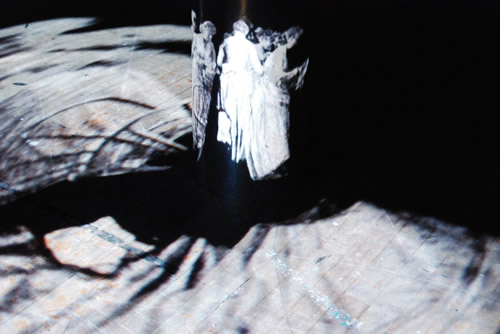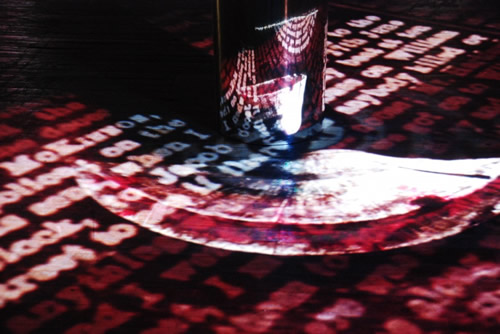
Back to archives | Back to FOFA Gallery
fofa_122011 JULY 6 - 9 GRIFFINTOWN: INSIDE STORIES Artists: Alice Jarry, Alison Loader and Marie-Andrée Pellerin Curator: Shauna Janssen In conjunction with the School of Canadian Irish Studies 2011 Annual Conference Hosted by the School of Canadian Irish Studies, and the Department of Design & Computation Arts, Concordia University, Montreal
"Ghosts in the Machine", Video installation by Alison Loader. Photo by Shauna Janssen. "Griffintown: Inside Stories" is an exhibition held at the FOFA Gallery of Concordia University in conjunction with the annual conference of the Canadian Association for Irish Studies. The conference theme, Text and Beyond Text in Irish Studies: New Visual, Material, and Spatial Perspectives, signals an opportunity to bring attention to the fine arts, to privilege the voices of artists and designers within the broader academic discourse of Canadian Irish Studies. The installations are part of an exploration of Griffintown past and present that will take place on Saturday July 9: a round-table discussion amongst scholars from other disciplines as well as members of the Montreal Irish community will complement a series of artist’s talks in the Gallery. Rhona Richman Kenneally and Michael Kenneally, co-organizers of the CAIS conference, would like to express their sincere thanks to jake moore, Shauna Janssen, Sabrina Russo and Sara Spike, as well as Alice Jarry, Alison Loader, and Marie Andrée Pellerin, for their efforts and support on this project. We are grateful for the financial support of the Faculty of Fine Arts.
Curator
Alice Jarry Pour la déscription en français, cliquez ici "Life in a Box: Building Tomorrow Today", which was first based on a series of in situ works, deals with topographical, historical and community changes in Montreal’s Griffintown neighbourhood. The work is an interrogation of themes of density, memory, scale and disappearance. It investigates the relationships and tensions that exist between analog media (silk-screen printing) and digital media (video), between continuity and discontinuity, between the ephemeral and the permanent. In this project, the exploration of vague and often imaginary boundaries between places and non-places becomes a double vision of the same state. The city and urbanity are perceived as an accumulation, a hybrid assembly, the raw material with which I try to capture structural and experiential dimensions. Life in a Box: Building Tomorrow Today, a permanent iteration of doing and undoing and a simultaneous representation of different places and superposed narrative frames, explores the emerging and unexpected possibilities of ephemeral and transitory places: How does a living environment grow? How do affects operate in a brand-new place? How can a sense of belonging emerge in Griffintown? How can we play with the density of the indeterminate, of the existing, in order to generate and represent new dynamics and new patterns to this neighborhood? My interrogation focuses on the way we foresee Griffintown’s revitalization. What is our ability to live in the here and now without bulldozing the past or short-circuiting the future? Collectively, can we still dream and imagine something else besides Life in a Box?
Alison Loader Pour la déscription en français, cliquez ici
"Ghosts in the Machine", Video installation by Alison Loader. Photo by Shauna Janssen.
"Ghosts in the Machine: The Inquest of Mary Gallagher" is inspired by the wandering “Ghost of Griffintown,” which arose from the 1879 murder and partial dismemberment of Mary Gallagher. Using mirror anamorphosis to re-form imagery in cylindrical reflections, it presents a narrative of how Mary lost her head and her alleged killer Susan Kennedy lost her freedom. Drawing primarily from English-language dailies of the past, and employing animated maps, 19th century photography, illustrations, and contemporary reenactments of inquest testimony, the project examines how the murder and its representation reveal points of view about gender, class, ethnicity and madness in Victorian Montreal. An intricate fifteen-minute loop of overlapping details about the crime and the time disrupts the local legend to present multiple ways of looking at Mary, Susan and Griffintown.
This form of expanded cinema – anamorphic moving images – emphasizes the constructed and subjective nature of truth. Images and text appear simultaneously distorted and undistorted; their legibility in mirrored reflections are wholly dependent on where the viewer stands and looks. In Ghosts in the Machine, the viewer is obliged to modify their positioning to perceive different elements but no matter where they stand, will never be able to read the entire work at once.
Marie-Andrée Pellerin Pour la déscription en français, cliquez ici
The “Généalogies suivi de Entretien (Griffintown)” installation is the culmination of a series of explorations in Montreal’s Griffintown neighbourhood, in which the artist isolates two steps of her creation process. This work uses the mapping method as an attempt to establish a dialogue with places by visiting them repeatedly. The objective is to create a bilateral exchange between the individual and the urban landscape by seeking to move away from a purely anthropocentric vision. The installation is composed of two parts. First, a family tree made of pieces of wood collected in Griffintown highlights the formal potential of this waste material. It attempts to make a link between their morphologies and the colour code imposed on them. This part of the work is a testament to anthropocentrism, through the action of giving these pieces of wood a genealogical evolution like that of human beings. The second part reveals the in situ nature of the work – the artist was guided by the specific parameters of the site itself. In addition to its reference to a specific place in Griffintown, the sharp angle created using one of the gallery’s movable walls indicates the desire to create a dialogue with the gallery space. A real correspondence is underway here with the landscape of Griffintown, at the junction between man and nature.
ROUND-TABLE DISCUSSION Saturday July 9, 1:00pm GRIFFINTOWN: Inside Stories Concordia University, EV Building, 1515 Ste-Catherine West, room 1. 715 and 1.615
1:00-2:00pm 2:00-3:00pm:
In addition to the academic panels and keynote lectures, the 2011 CAIS conference will be hosting several cultural events, all open to the public. For all events, a block of seats will be reserved for registered conference participants. |
|---|
© Concordia University

